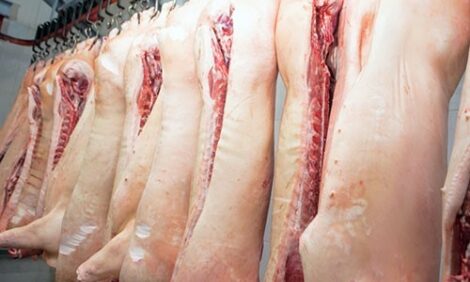



China: Hog Markets
CHINA - With over 51 per cent of the world's pig being raised in China that makes the Chinese are the pork powerhouse of the world and the breeding stock increased by over a million on last year, writes Ron Lane, Senior Consultant for Genesus China.Looking at the size of the breakdown of the inventory for September, 2012-breeding stock was around 50.79 million and total on farm inventory was around 470.94 million (as compared to August 2012-breeding stock was around 49.74 million and total on farm inventory was around 464.90 million).
The 470.94 million head for September is up 1.50 per cent from last year while the September sow inventory is up 4.70 per cent from last year (year over year). Sow inventory had been quite flat from January to July. The larger increase in on farm pig inventory from last month shows that the effect that disease has had during the late fall (2011) and early winter(2012) on piglet numbers is easing up and piglet survivability has improved.
Sow inventory for September 2012 is the highest number for the month of September in four years. For 2012, total farm inventory is projected to increase by 5 to 6 per cent. In 2011, the average inventory for breeding stock was 49.29 million and total on farm inventory was 468 million.
Profit margins continue to show declining returns. Current profit margins are showing a profit of 74 RMB/head-$11.86 USD/head average (but there is a vast range from losses of 200 RMB/head-$ 32.05 USD/head in some major pork production regions. Many farmers are saying they are below breakeven.
Other farmers indicate some profits getting to 100+ RMB/head-$ 16.02+ USD/head). During the 3rd week of June, 2012, the estimated profit margin was 136 RMB/pig- $ 21.79 US/pig.
At the end of March the profit margin was at 187 RMB/market pig-$29.97 US; down as compared to late January at 600 RMB/market pig-$ 96.15 USD. Estimated profit margin for June, 2011, was around 770 RMB/market pig -$123.40 USD and was the peak price. Average profit for 2011 was estimated at 500 RMB/market pig-$ 80.13 US.
One farmer outlined his current loss figures to the Xiaoxiang Morning. Zhang Zhongping explained his loss position/calculations: "Six months ago, he purchased his 100 piglets for a purchase price of 400 RMB per pig ($ 64.10 USD/pig).
They consumed 800 pounds of feed (363kgs); feed prices rose to 1.8 RMB per jin (jin= 500 gms), thus feed is 3.6 RMB/kg-$0.577 USD/kg); total money spent on feed was 1,440 RMB ($ 230.77 USD). When he adds in other costs of production, the total cost per pig is 1,900 RMB ($ 304.49 USD/pig).
Slaughter weight of the pigs was estimated to be 240 pounds (108.89 kgs). The market price is 7.12 RMB per hundred pounds of live pigs (45.37 kgs), each pig sells for only 1710 RMB ($ 274.04 USD/pig). Even without charging his labour, per pig loss of about 200 RMB ($ 32.05 USD)“.
Currently, piglet price has dropped in half since he bought his first group, but Zhang Zhongping is not sure he still can feed pigs for profit or if he wants to continue raising pigs.
Farms with large upfront investment can not change the farm use. The investment in specialized equipment and facilities can not be quickly changed from one enterprise to another. They can cut back some production. However, the small-scale pig farmers have been "voting with their feet". In the past two years, the "pig cycle" has shown more frequency. With every fluctuation there is more industry adjustment. A lot of small-scale pig farms have been closed or have quit. (Sina agriculture)

What to watch for over the next few months
In September, 2011 the pig to corn ratio was 8.24:1 and in November, 2011, a pig to corn ratio of 7.42:1 was shown. For January, 2012, a 7.79:1 ratio was calculated. For the timeframe of the week of November15th, 2012, pig prices rose slightly, but the main wholesale market for corn prices dropped even more.
Pig to grain price rebounded to 6.53:1 (an increase from last week —but down 10.3 per cent from one year ago) It has been several weeks now that the pig to grain ratio is above the universally recognized breakeven point of 6.00:1 or better).
For the month of October, the price of live pigs nationwide had an average price of 14.85 RMB/kg ($2.38 USD/kg), down 0.3 per cent from September and a decrease of 21.6 per cent over the same period last year.
Live pig prices varied from provinces to provinces with 10 provinces showing price increases and 20 provinces showing falling prices. Northwest China had a higher average price of 16.02 RMB/kg ($2.57 USD/kg) whereas the Northeastern region had lower prices of 14.35 RMB/kg ($2.30 USD/kg). For the month of October, the price of pork nationwide had an average price of 23.92 RMB/kg ($ 3.83 USD/kg), up 0.5 per cnet over the previous month and a decrease of 19.7 per cent over the same period last year.
Pork prices varied from provinces to provinces with 20 provinces showing price increases and 10 provinces showing falling prices. Northwest China had a higher average price of pork of 25.46 RMB/kg ($ 4.08 USD/kg) and the Northeastern region had lower prices for pork of 22.80 RMB/kg ($ 3.65 USD/kg). For the month of October, the monthly average price for piglets was 27.72 RMB/kg ($4.44 USD/kg), down 3.8 per cent from the September average and down 22.7 per cent from last year-October 2011.
For the month of September, the average national corn price was 2.51 RMB/kg ($0.40 USD/kg), down 2.3 per cent from last month and a year-on-year price increase of 2.4 per cent. The main production areas of the northeastern provinces showed an average corn price of 2.37 RMB/kg (0.38 USD/kg), down 0.8 per cent. from last month.
Guangdong province had the highest average price of 2.70 RMB/kg ($0.43 USD/kg), with a 2.9 per cent decline from the previous month. As well, the average national soybean meal monthly price was 4.39 RMB/kg ($0.70 USD/kg), down 2.9 per cent , but with a huge year-on-year rise of 23.0 per cent. Market pigs feed averaged 3.28 RMB/kg ($0.53 USD/kg). For comparison, broiler feed was 3.36 RMB/kg ($0.54USD/kg) and for laying hens, it was 3.09 RMB/kg ($0.50 USD/kg).
These prices are down: for pigs (0.3 per cent), for broilers (0.6 per cent) and for hens (0.3 per cent) However, average complete feed for pigs is up 7.5 per cent, for broilers, up 6.0 per cent and for layers up 6.2 per cent compared to last year. In the last six consecutive weeks, corn is down by 4.3 per cent and soybean meal is down 5.9 per cent.
The Consumer Price Index (CPI) continues to be quite interesting for the National Government. Previously, when the pork prices were gaining, this rapid increase in pork, gained the attention of the National Government as it greatly affects the CPI.
The CPI is made up of 30.49 per cent food found in the consumers’ basket. Pork is estimated to be about 1/3 of the food portion of the basket or in other words, about 8 to10 per cent of CPI as a whole. Thus, with these calculations in mind, the price of pork in the entire CPI weighs between 2.5 per cent to 3 per cent. This level is much larger than the world's major pork producing and consuming countries, such as Japan (0.66 per centfactor), United States (0.34 per cent factor) and in Germany (0.71 per cent factor) on CPI.
Currently, inflation is around 1.6 per cent for October as compared to August at 2.0 per cent and September at 1.8 per cent (with October being the lowest level-33 month low since February, 2010). This is a drop from the high of 6.5 per cent in July, 2011 (37 month high).
Analysts expected that the years’ average CPI will decline to 3.3 per cent from 5.4 per cent in 2011. (For the first 9 months of 2012, inflation has averaged 2.84 per cent).
This is lower than the 4 per cent set by the National Government. This may give more space for the government ministries to readjust macro-economic policy. For the 4th quarter, Dr. Wang Yu Wen, from the Bank Financial Research Centre, suggests that the CPI year-on-year will be about 2.3 per cent higher than the recently completed third quarter and for next year having a CPI that could be 3.5 per cent.
The national average corn price for November 15th, 2012 was 2.24 RMB/kg ($0.359 USD/kg), the national average wheat bran price was 1.80RMB/kg ($0.288 USD/ kg) and the national average soybean meal price was 4.14 RMB/kg ($.663 USD/kg).
National average feed costs were 3.14 RMB/kg ($0.503 USD/kg). For the first 9 months of 2012, livestock and poultry production was a total of 57.28 million tons, year-on-year growth of 5.0 per cent.
Pork production was 37.54 million tons (an increase of 5.2 per cent); the pig herd was calculated to be 468.22 million head (up 1.9 per cent from last year) and pig slaughter was 492,980,000 head (an increase of 5.1 per cent over the first 9 months of 2011.
Mexico has started exporting pork to China, with an expected market value of over $35 million for this year.
Since 2001, large specialized and/or commercial farms have been rapidly increasing in market pig production in contrast to the formerly largest production base from the backyard farms (backyard production has dropped from 74 per cent of total hog production in 2001 down to 37 per cent in 2011).From Rabobank International)
China’s corn harvest reached a record for this year. In spite of a strong typhoon that hit major corn producing areas, the harvest increased by 3.6 per cent to 119.74 million tonnes. Geneva-based SG SA in their survey for Bloomsberg, checked with production in the seven major corn producing provinces in China.
On hand inventory is at a nine year high. This higher new inventory is good news for Chinese users as imports from the USA is predicted to be 64 per cnent less for China this crop year.









